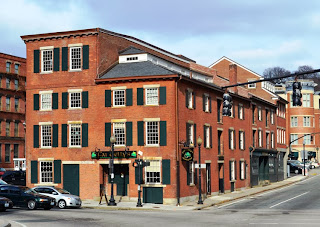 |
| Seril Dodge House, Thomas St., Providence. |
My Mom's silver was Gorham too. The "Lyric" pattern was introduced in 1940, so it was still a new pattern when she was married during the war in 1944.
This all came rushing back to me during the past month while I researched the history of Gorham for a special walking tour I conducted (along with two other guides) last Saturday. It was cosponsored by the Rhode Island Historical Society and the Rhode Island School of Design (RISD) Museum, and we visited both locations plus a number of stops in between.
To tell the story of Gorham, we need to go back to 1784 when two men named Seril and Nehemiah Dodge moved from Connecticut to Providence. They were either half-brothers, or uncle and nephew, and they are credited with developing the process of electroplating--depositing a thin layer of gold or silver on copper. Keeping in mind that only the well-to-do could afford jewelry made of pure silver and gold, the Dodges were able to make jewelry that could be sold to a wider audience.
Seril built two houses on Thomas Street in Providence in the late 1780s and early 1790s; both are still standing and now part of the Providence Art Club. He returned to Connecticut in 1796, but Nehemiah stayed in Providence. He opened a shop on Main Street, and he advertised his business in 1798 as selling "gold necklaces, knobs and twists, gold rings, miniature cases, and fine jewelry."
 |
| Jabez Gorham House, 56 Benefit Street, Providence. |
Jabez and Caty Gorham had eight children--their fifth child, born in 1792, was called Jabez like his father, grandfather, and great-great-grandfather before him. When young Jabez was 10 years old, his father died. This must have created financial pressure on the family, and at 14 Jabez was indentured as an apprentice to his neighbor, Nehemiah Dodge, to learn jewelry making.
 |
| 3 Steeple Street, Providence. |
The Firm prospered for a few years, but hit a snag in 1818 and the partnership dissolved. However, Jabez Gorham stayed in business at the same location, operating under the name Jabez Gorham, Jeweler.
In the 1820s, with his business expanding, Jabez moved across the street to #12 Steeple. He was one of the first to manufacture what was called "French Filigree" jewelry, competing successfully with imported goods. He also designed a special kind of gold chain which became known as "The Gorham Chain." He sold goods from his shop on Steeple Street, and through peddlers--the manufacturer's reps of the day. He also traveled throughout New England and New York on sales trips himself. So he was a manufacturer, a retailer, a traveling salesman, and a sales manager--all at the same time!
 |
| Gorham coin silver spoon, ca. 1845. |
1831 is considered to be the year that Gorham Silver was founded.
(to be continued)
Illustration Credits and References
Jabez Gorham house photo by the author.
3 Steeple Street photo from the Carlisle Wide Plank Floors website.
Gorham coin silver photo by Replacement Sterling 925 on eBay.
An exhaustive history of Gorham can be found in the book Gorham Silver by Charles H. Carpenter, Jr. (Revised edition published by Alan Wofsy Fine Arts, San Francisco, 1997.)
I always liked your silver pattern - and were I to pick a pattern (which I never did - I don't recall it even being discussed) - I would still pick that one over the other ornate, more symmetrical patterns. But, then, I love Disney :)
ReplyDeleteI love it because of what it represents….it's very special to me.
ReplyDeleteI am a Howland descendant, born in MA now retired in MO. This article was very interesting. I had no idea the family was tied to Gorham silver!
ReplyDeleteGlad you enjoyed it! There are several other parts to this (look in the "Blog Archive" section at the right for posts from November and December 2013.)
ReplyDeletei to am howland descent
ReplyDeleteThanks for reading, Karla!
ReplyDeleteI am a Howland-Gorham descendent as well! Sue Harteau Beauchamp
ReplyDeleteThanks for reading!
Delete